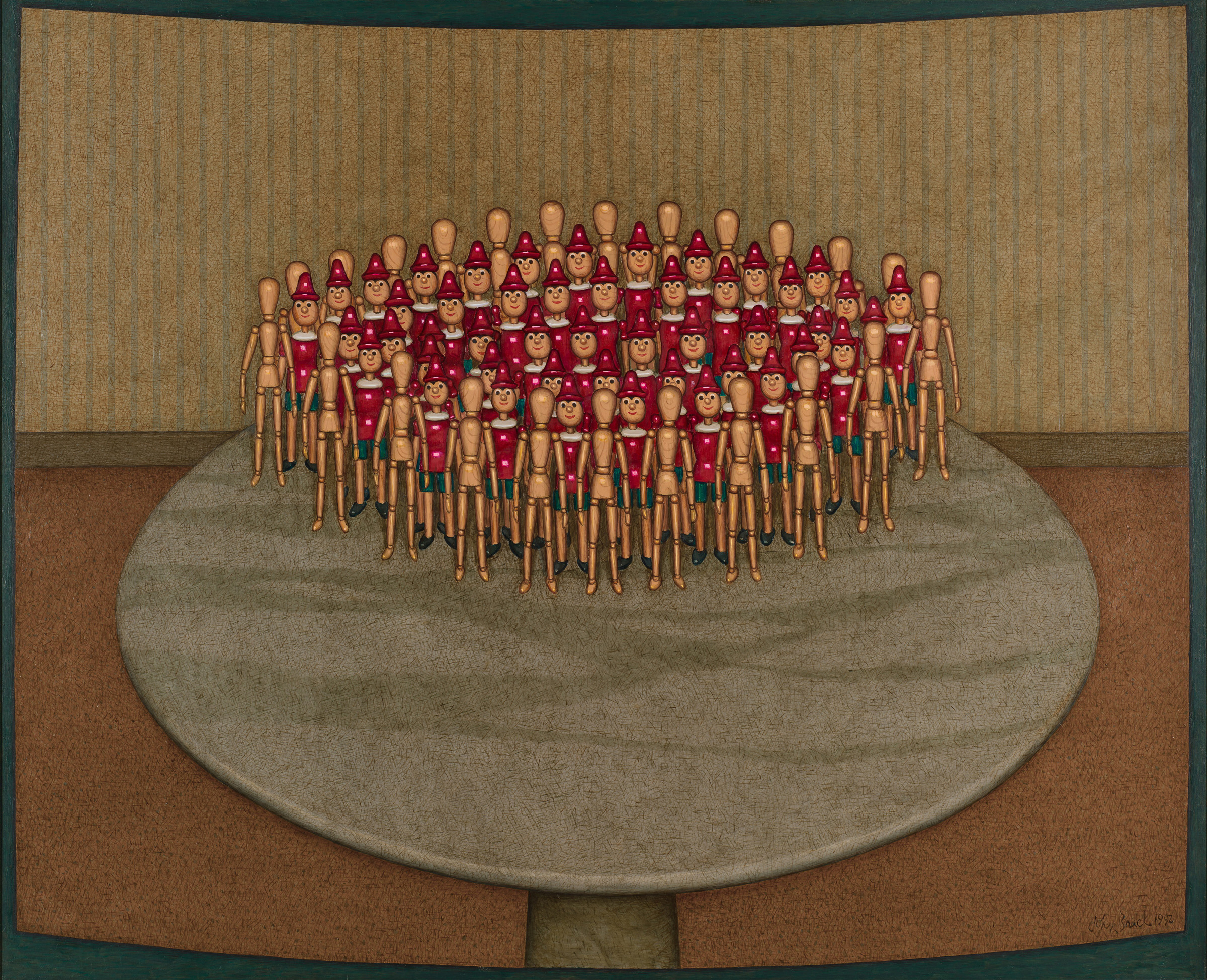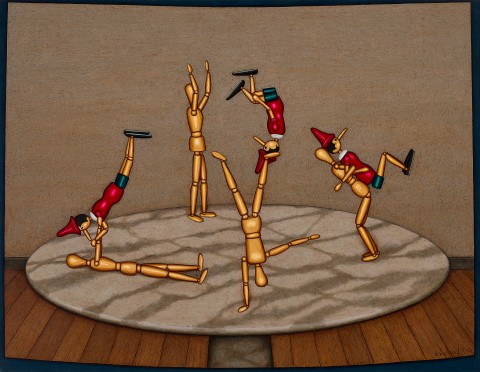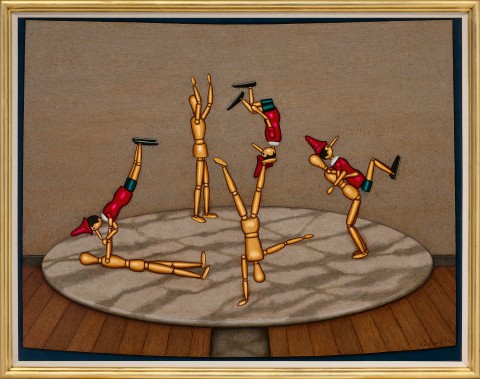SEVEN ON THE TABLE, 1990
JOHN BRACK
oil on canvas
106.5 x 137.0 cm
signed and dated lower right: John Brack 1990
inscribed with title and date on artist’s label verso: SEVEN ON THE TABLE / 1990
bears inscription on frame verso: SEVEN ON THE TABLE
Private collection, Melbourne, acquired directly from the artist in February 1998
John Brack, Tolarno Galleries, Melbourne, 7 September 1991, cat. 6
John Brack: selected paintings 1950s to 1990s, Geelong Art Gallery, Victoria, 15 June – 14 July 1996
A Question of Balance, John Brack 1974 – 1994, Heide Museum of Modern Art, Melbourne, 1 April – 28 May 2000
Gott, T., A Question of Balance, John Brack 1974 – 1994, Heide Museum of Modern Art, Melbourne, 2000, pp. 36 (illus.), 37, 47
240481-Brack-Finale.jpg

John Brack is renowned as the artist who most succinctly captured the character of twentieth century Australian life. His iconic paintings including The bar, 1954 and Collins St, 5p.m., 1955 (both National Gallery of Victoria), together with the ballroom dancing series of the late 1960s, are eternally popular with successive generations of viewers and now, more than fifty years on, also tinged with nostalgia for our recent past.
While Brack’s imagery was often interpreted as satirical social commentary, his primary motivation was quite different. As he explained, ‘What I paint most is what interests me most, that is, people; the Human Condition… A large part of the motive… is the desire to understand, and if possible, to illuminate… My material is what lies nearest to hand, the people and the things I know best.’1 Throughout a career that spanned more than five decades Brack’s work evolved both stylistically and technically, as well as witnessing distinct changes of subject matter, however this focus on the human condition remained a consistent theme.
Ironically, in the mid-1970s the human figure disappeared almost entirely from Brack’s imagery, replaced in ensuing series by various inanimate objects, from museum postcards, umbrellas, pens, pencils and playing cards, to wooden artists’ manikins and Pinocchio dolls. Using these everyday props to construct subtle visual metaphors, Brack’s new approach ‘[permitted] him to express the whole complexity of social interconnections’2 and his perspective on the perennial forces of human nature was transformed from the local to a broader universal view.
Brack turned seventy in 1990 and many of the works made around this time show the artist reflecting on his own experience of life as well as looking forward. As Helen Brack recalled, ‘John was getting older, and so he was starting to think of the future – not his future but the future… (He realised) that it was the same again – we’d very much seen this, been there. That was the beginning of his making an image for perpetuation… There is an optimism at the end of John’s life that wasn’t there earlier.’3 In this context, the acrobatic manikins and wooden Pinocchio dolls that tumble, leap and wrestle across Seven on the table, 1990 reflect the carefree confidence, energy and freedom of youth. This was the first occasion that Brack included the figure of Pinocchio in his painting, inspired by a conversation with his grandson about a children’s film that was followed by coincidental sightings of these painted wooden dolls in shop windows. As Ted Gott has explained, ‘the linking of the imagery as a motif for boyhood was natural and fluid. Seven on the table shows us little boys playing, tumbling and ‘roughing it up’. It celebrates Brack’s relationship with the first boy in his family, after a lifetime spent surrounded by the female element (a wife, four daughters, and granddaughters). The Pinocchio motif stands for the male force in life, for the unstoppable nature of all small boys’ playing and fighting.’4
240481 John brack.jpg

The field occupied by the playing figures is a circular marble table depicted in a sparse interior of timber floorboards and a bare wall behind. While the focus is on the manikins and Pinocchio dolls, every detail of the painting reflects the meticulous finish that characterised Brack’s work from this time. Produced in his studio, the late paintings were the result of intense preparation and technique. Setting up elaborate tableaux using fishing line and tape to suspend props when necessary, he would create a model from which a detailed preparatory drawing was made. He also used fine brushes and glazes to minimise the appearance of brushstrokes and heighten the sense of pictorial realism in these works, aiming to engage viewers so that they could focus on the meaning of the imagery rather than being distracted by expressive painterly bravura.5
John Brack has long been recognised as a towering figure within twentieth century Australian art, one of the few artists of his generation who addressed the reality of life as it was lived in the cities and the suburbs. As Patrick McCaughey observed however, ‘even if he may look direct, accessible and easy to read… the imagery retains an ambiguous and enigmatic quality. Paintings infer hidden meanings; references just beyond the grasp or consciousness of the viewer.’6
1. John Brack, cited in Reed, J., New Painting 1952-62, Longman, Melbourne, 1963, p. 19
2. Grishin, S., The Art of John Brack, Oxford University Press, Melbourne, 1990, p. 140
3. Helen Brack, cited in Gott, T., A Question of Balance: John Brack 1974 – 1994, Heide Museum of Modern Art, Bulleen, 2000, p. 34
4. ibid, p. 37
5. Grishin, op. cit., p. 132
6. McCaughey, P., ‘The Complexity of John Brack’ in Lindsay, R., John Brack, National Gallery of Victoria, Melbourne, 1987, p. 7
KIRSTY GRANT


